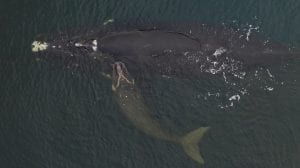Migratory culture in southern right whales
Southern right whales migrate thousands of kilometres between high-latitude feeding grounds and coastal winter calving/breeding grounds. Females have calves around about every three years, and the calf migrates with its mother to her preferred feeding ground, and often back to their natal wintering ground. In this way, it seems the calf can learn it’s mothers preferred migratory destinations. This behaviour seems to have shaped the pattern of maternally-inherited mitochondrial DNA of southern right whales around the world.

Tohora – Eubalaena australis (Southern Right Whale) expedition at Port Ross in the subantarctic Auckland Islands, New Zealand. Sunday 02 August 2020. Photograph Richard Robinson © 2020. Rights managed image. No Reproduction without prior written permission.
Integrating animal culture into conservation
Animal culture and social complexity, such as migratory culture, need to be considered in conservation management plans. The lack of recovery and recolonisation of southern right whales in much of their historic range has been used as an example of this in the United Nations Environment Program/Convention of Migratory Species (UNEP/CMS) workshop reports that led to UNEP/CMS/Resolution 11.23 that encouraged parties to the CMS to gather data on culture and social complexity for the purposes of conservation management. In addition to this policy application, our work on southern right whales has been highlighted in the literature as a key example of migratory culture (e.g., Whiten 2017, PNAS https://doi.org/10.1073/pnas.1620733114).